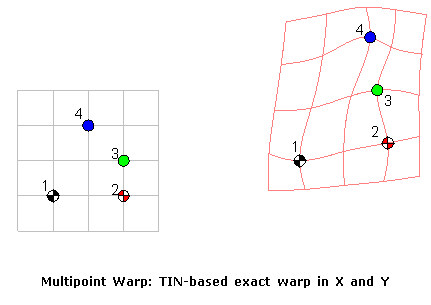The Multi-point Warp

The multi-point warp is designed to provide an exact warp for any number of locations; in other words, once defined, the warp will faithfully convert any location which coincides with an original warp definition location. This is in contrast to a least-squares type of warp, where a simple warp is applied that minimizes in a least-squares sense the error between the calculated and actual "new" locations of the defined points. In effect, the multipoint warp is like a rubber sheet which is stretched by different amounts at different places, but which is pinned at the definition locations.
The multipoint warp begins by calculating two TINs (Triangular Irregular Network) from the input point locations. The "Z" values for the first TIN are the "corrections" that need to be applied to the X value to give the warped X value. The "Z" values for the second TIN are the Y-value corrections. The natural-neighbour method is then used to calculate, at any location within the convex hull of the TIN the X and Y corrections required at that location. It is an intrinsic property of the natural-neighbour method that the correction values calculated at the TIN nodes are exactly the original node values, and the values are smooth to the second derivative between the nodes.
To warp a single point, the algorithm first locates the point within the TINs, and, using the correction values of the "natural neighbour nodes", calculates an interpolated correction value for X and for Y. The correction is added to the original value to give the warped point location.
A drawback of this method is that the interpolation can only be done for points lying within the convex hull of the defining points. It is recommended, therefore, that the corner locations be included in the set of defining points.
The implementation of this method in Geosoft attempts to extend the interpolation beyond the convex hull of the defining points by adding another four "corner" points at some distance outside the defining points, and setting the correction values at these locations to be equal to the RMS average correction of all the points. This allows you to interpolate beyond the original convex hull, but the method becomes increasingly inaccurate the farther you go beyond the original points, so it should be done with care.
Got a question? Visit the Seequent forums or Seequent support
© 2023 Seequent, The Bentley Subsurface Company
Privacy | Terms of Use
